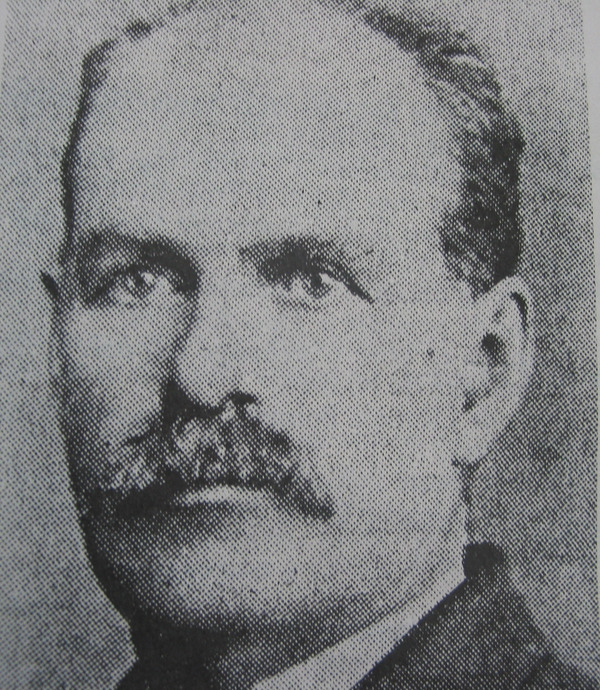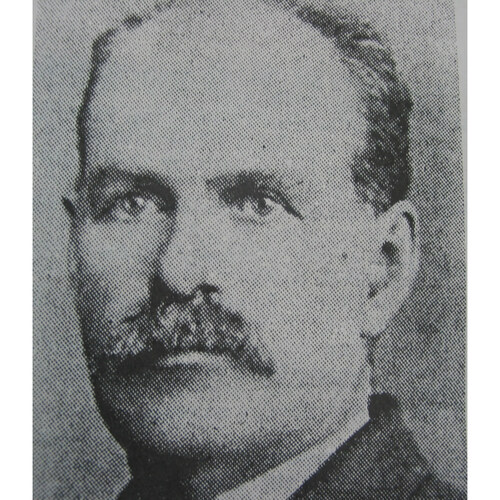
Source: Courtesy of Wikimedia Commons
RHO (Raux, Rheault), ADOLPHE, wood-carver, portrait artist, and painter; b. 30 March 1839 in Gentilly (Bécancour), Lower Canada, son of Alexis Raux and Marie des Anges Girouard; m. first 6 Feb. 1865 Philomène Boisvert in Bécancour, and they had ten children, two of whom died in infancy; m. secondly 13 July 1885 Éléonore Boisvert, Philomène’s sister, in Cap-Rouge, Que.; d. 7 April 1905 in Bécancour.
Being a farmer’s son, Adolphe Rho started to work at an early age. When his father did not need him for seasonal tasks on the farm, he attended the village school. Olivier Aubry, the schoolmaster, taught him the rudiments and probably encouraged Rho, who was better than his classmates at drawing, to develop his natural talent. Thus a few years later Rho took “lessons in drawing and perspective” in Trois-Rivières. During the long winter months when work on the farm slowed down, he turned to woodcarving. He must have shown himself to be gifted and indeed skilful since on 10 Jan. 1860, when he was only 20, he was hired as an apprentice architect and wood-carver to put the finishing touches to the parish church. His first known work was some “representational wood-carving, in particular the bas-reliefs put in the sanctuary” of the church.
When Rho married Philomène Boisvert he listed himself in the register as a wood-carver and signed Rheault. The young couple took up residence at Bécancour. At the baptism of their first child on 25 Feb. 1866 he signed Rho, as he always did thereafter. Nothing is known of his early years in Bécancour except that, by dint of many personal sacrifices, he continued “to practise wood-carving in his shop, [which was] fitted out as a studio.” He was skilful and ingenious, and probably turned his hand to a myriad of things in order to make ends meet.
In the autumn of 1870 Rho announced that he was opening a studio on Rue Saint-Jean, at Quebec, in the gallery of photographer George William Ellisson. He had perfected a “new process” for portraits. The method was simple: an enlargement of a photograph was made and the features were redone by the artist in pastel, charcoal, or crayon. In this way the portrait gave the illusion of being done solely by hand, “with a finish that can hardly be distinguished from a painting.”
Rho spent long periods at Quebec, for he was unexpectedly successful and orders kept pouring in. Bishops and parish priests, politicians and businessmen sought his services; numerous lithographs of the portraits were put on the market. Newspapers sang his praises unceasingly, and he was seen as the “up-and-coming genius.” In 1871 he displayed his works in the bookstores in Montreal and had several pencil drawings in the Quebec exposition.
Having become a successful portrait artist, in 1878 Rho turned to painting in oils. After only a few months’ apprenticeship, he did a canvas entitled Marie Madeleine that revealed, according to Le Journal des Trois-Rivières, “the sacred flame of inspiration served by an above-average talent.” Rho was probably less enthused about his early canvasses and knew that he had a great deal to learn. On 19 October he sailed for Europe to improve his art through contact with the French masters. Charles Huot*, who studied under Alexandre Cabanel, introduced him to the Parisian painters and took him to the museums and art galleries. Unfortunately Rho had to return to Canada when a member of his family fell ill. This contretemps did not discourage him, and he took up his work with renewed vigour. In May 1879 for the first time he exhibited a canvas in Jean-Moïse-Arthur Lavigne*’s shop at Quebec. It was an oil after a copy of a famous painting belonging to the Ursulines, Mme Vigée-Lebrun par elle-même. A pastel of this picture was also displayed. Rho experienced further misfortune when on 23 Aug. 1881, a scant year after the birth of his last child, he lost his wife. He later carved a granite tombstone to her memory.
Rho dreamed of returning to Europe, and particularly to Italy. He resolved to go on the first Canadian pilgrimage to the Holy Land, which his cousin by marriage Abbé Léon Provancher* was organizing. Seeking ways to raise the money he would need, he painted his first frescoes for the church in Nicolet, restored a few paintings in his parish church, and again took orders for crayon or oil portraits.
Leaving his children in the care of his sister-in-law Éléonore Boisvert, who had been living in his home since the death of his wife, Rho sailed from New York on 27 Feb. 1884. He went to Paris, Alexandria, Cairo, and Jerusalem, and then spent more than three months in Rome and Florence. The voyage proved highly productive; he visited artists and museums assiduously and continued to paint. In Rome he did the rough sketches for his most famous picture, the Baptême du Christ that still hangs in the church maintained by the Franciscans at Ein Karem, near Jerusalem.
His marriage in July 1885 to Eléonore Boisvert was followed by another period of accomplishment. He painted some 60 religious subjects and carved statues and retables. Frequently working with the aid of his four sons, he restored some 30 churches and chapels. In 1886 he spent several months at Quebec and completed the portraits of Leo XIII and Elzéar-Alexandre Cardinal Taschereau* that hang in the salon of the archbishop’s palace. In the first few months of 1889 he gave drawing and painting lessons in Trois-Rivières. A wood-carving after Leonardo da Vinci’s Last supper came out of his studio in the summer of that year. It remains the artist’s masterpiece, and many copies would be made of it.
Rho virtually confined himself to depicting religious subjects for churches and executing portraits in the manner of the period. The portraits belong to private collections that are often unknown; the religious pictures have been destroyed or have disappeared; the in-fresco decorations have not survived the renovation of the churches. The most eloquent witness to his wood-carving is borne by the bas-reliefs and the monumental Easter candelabra in the church of Gentilly.
Adolphe Rho died of pneumonia at Bécancour on 7 April 1905, less than two years after the death of his second wife. Self-educated as a portrait artist, painter, and wood-carver, he was seldom audacious, but always conscientious. Although he was lavishly praised by his contemporaries, he does not stand up well to modern criticism. He was nevertheless a skilful carver, a much sought-after portraitist, and a faithful copier. Craftsman more than artist, he put his talent at the service of a period still awaiting genius.
A list of works by Adolphe Rho as well as a complete bibliography can be found in Denis Fréchette, “Adolphe Rho, l’homme et l’œuvre,” Les Cahiers nicolétains (Nicolet, Qué.), 6 (1984): 3–62.
AC, Québec, État civil, Catholiques, Cap-Rouge, 13 juill. 1885. ANQ-MBF, CE1-4, 6 févr. 1865; CE1-9, 30 mars 1839.
Cite This Article
Denis Fréchette, “RHO (Raux, Rheault), ADOLPHE,” in Dictionary of Canadian Biography, vol. 13, University of Toronto/Université Laval, 2003–, accessed December 28, 2025, https://www.biographi.ca/en/bio/rho_adolphe_13E.html.
The citation above shows the format for footnotes and endnotes according to the Chicago manual of style (16th edition). Information to be used in other citation formats:
| Permalink: | https://www.biographi.ca/en/bio/rho_adolphe_13E.html |
| Author of Article: | Denis Fréchette |
| Title of Article: | RHO (Raux, Rheault), ADOLPHE |
| Publication Name: | Dictionary of Canadian Biography, vol. 13 |
| Publisher: | University of Toronto/Université Laval |
| Year of publication: | 1994 |
| Year of revision: | 1994 |
| Access Date: | December 28, 2025 |



